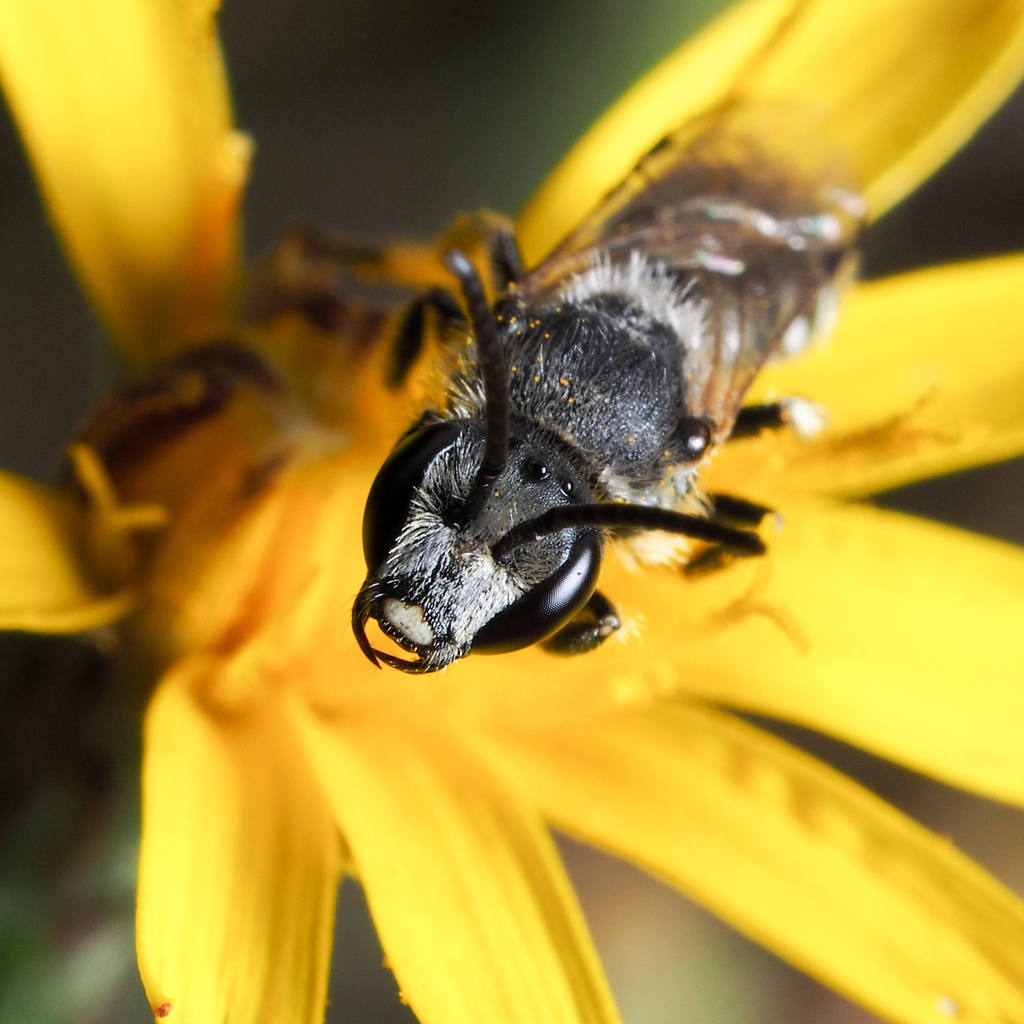White-banded sweat bee (Lasioglossum leucozonium)
Lasioglossum leucozonium is a widespread solitary sweat bee found in North America, Europe, Asia, and parts of northern Africa. While now a common bee in North America, population genetic analysis has shown that it is actually an introduced species in this region. Read more about white-banded sweat bees on iNaturalist.org.

Photo 23417963, (c) mick massie, some rights reserved (CC BY-NC), via iNaturalist.org ( https://www.inaturalist.org/photos/23417963)
Chromosome-length genome assembly
Download the LLEU_genome_v2.1.1.fasta.gz file containing the chromosome-length (2n=36) assembly of the white-banded sweat bee genome. All modifications with respect to the draft (see below) are annotated in the LLEU_genome_v2.1.1.assembly file. Some basic stats associated with the new reference, LLEU_genome_v2.1.1, are listed below. The full data release can be explored here.
Contig length (bp) | Number of contigs | Contig N50 (bp) | Longest contig (bp) |
|---|---|---|---|
282,818,279 | 8,015 | 351,627 | 2,512,702 |
Scaffold length (bp) | Number of scaffolds | Scaffold N50 (bp) | Longest scaffold (bp) |
|---|---|---|---|
283,111,487 | 5,859 | 13,877,945 | 27,342,619 |
Draft
The chromosome-length genome assembly is based on the draft assembly LLEU_genome_v1.0, credited below.
This genome assembly was created in collaboration with the Kocher Lab at Princeton University. The draft was assembled with Supernova assembler using 10x Genomics linked-read libraries. For details see https://www.biorxiv.org/content/10.1101/2021.04.14.439731v1..
Method
3D Assembly was performed using 3D-DNA pipeline (Dudchenko et al., Science, 2017). The genome was reviewed using Juicebox Assembly Tools (Dudchenko et al., bioRxiv, 2018). See Methods for more information.
Hi-C sample
The head and thorax sample for in situ Hi-C preparation was donated by a female individual named COI-eq ID: LLEU091, Legacy ID: LLEU091, 4-letter alias: LLEU, alt: Apo0096, and obtained from Kocher Lab, Princeton University.
Hi-C Contact maps
Hi-C data was aligned to the draft reference using Juicer (Durand, Shamim et al., Cell Systems, 2016), and contact maps visualizing the alignments with respect to the draft and the new reference were built using 3D-DNA (Dudchenko et al., Science, 2017). The contact maps can be explored below via Juicebox.js interactive tool (Robinson et al., Cell Systems, 2018). To explore the assembly in greater detail, please download the .hic and .assembly files from the data release folder and use Juicebox Assembly Tools (Dudchenko et al., bioRxiv, 2018).
References
If you use this genome assembly in your research, please check that the conditions of use associated with the draft permit it, and acknowledge the following work.
This genome assembly was created in collaboration with the Kocher Lab at Princeton University. The draft was assembled with Supernova assembler using 10x Genomics linked-read libraries. For details see https://www.biorxiv.org/content/10.1101/2021.04.14.439731v1..
Dudchenko, O., Batra, S.S., Omer, A.D., Nyquist, S.K., Hoeger, M., Durand, N.C., Shamim, M.S., Machol, I., Lander, E.S., Aiden, A.P., Aiden, E.L., 2017. De novo assembly of the Aedes aegypti genome using Hi-C yields chromosome-length scaffolds. Science 356, 92–95. https://doi.org/10.1126/science.aal3327.
Dudchenko, O., Shamim, M.S., Batra, S., Durand, N.C., Musial, N.T., Mostofa, R., Pham, M., Hilaire, B.G.S., Yao, W., Stamenova, E., Hoeger, M., Nyquist, S.K., Korchina, V., Pletch, K., Flanagan, J.P., Tomaszewicz, A., McAloose, D., Estrada, C.P., Novak, B.J., Omer, A.D., Aiden, E.L., 2018. The Juicebox Assembly Tools module facilitates de novo assembly of mammalian genomes with chromosome-length scaffolds for under $1000. bioRxiv 254797. https://doi.org/10.1101/254797.
Disclaimer
This is a work in progress. If you notice any discrepancies in the map or have data that confirms or contradicts the suggested reference, please email us at thednazoo@gmail.com or leave a comment on the Forum.
